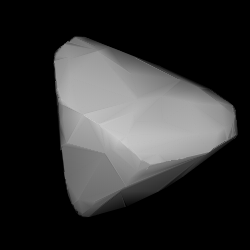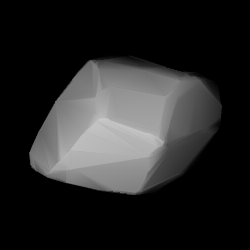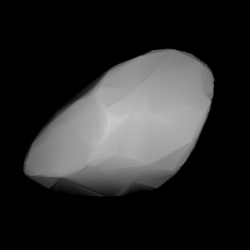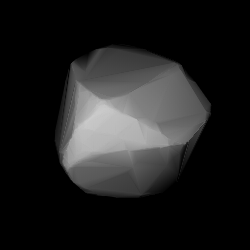Related Research Articles

748 Simeïsa is a very large Hilda asteroid from the outermost regions of the asteroid belt, approximately 104 kilometers in diameter. It was discovered on 14 March 1913, by Russian astronomer Grigory Neujmin at the Simeiz Observatory on the Crimean peninsula. The dark P-type asteroid has a rotation period of 11.9 hours and a shape that is reminiscent of a tetrahedron. It was the first asteroid discovery made in Russia and named after the discovering observatory and its nearby Crimean town, Simeiz.
751 Faïna is a very large background asteroid from the central regions of the asteroid belt, approximately 110 kilometers in diameter. It was discovered on 28 April 1913, by Russian astronomer Grigory Neujmin at the Simeiz Observatory on the Crimean peninsula. The elongated C-type asteroid (Ch) has a rotation period of 23.7 hours. It was named after Faina Mikhajlovna Neujmina, colleague and first wife of the discoverer.
779 Nina is a large background asteroid, approximately 80 kilometers in diameter, located in the central region of the asteroid belt. It was discovered on 25 January 1914, by Russian astronomer Grigory Neujmin(1886-1946) at the Simeiz Observatory on the Crimean peninsula. The metallic X-type asteroid with an intermediate albedo has a rotation period of 11.2 hours. It was named after the discoverer's sister, Nina Neujmina (Tsentilovich) (1889–1971).

791 Ani is a very large asteroid of the Meliboea family, located in the outer regions of the asteroid belt. It was discovered on 29 June 1914, by Russian astronomer Grigory Neujmin at the Simeiz Observatory on the Crimean peninsula. The dark carbonaceous C-type asteroid has a rotation period of 11.2 hours and measures approximately 65.7 × 103.5 kilometers, with a mean-diameter of 100 km (62 mi). It was named after the historic Armenian city of Ani.
814 Tauris is a dark and very large background asteroid, approximately 109 kilometers in diameter, located the outer regions of the asteroid belt. It was discovered on 2 January 1916, by astronomer Russian Grigory Neujmin at the Simeiz Observatory on Crimea. The carbonaceous C-type asteroid has a longer-than average rotation period of 35.8 hours. It was named after the ancient name of the Crimean peninsula where the discovering observatory is located.

877 Walküre is a dark background asteroid from the inner regions of the asteroid belt, approximately 38 kilometers in diameter. It was discovered on 13 September 1915, by Russian astronomer Grigory Neujmin at the Simeiz Observatory on the Crimean peninsula. The carbonaceous F/C-type asteroid has a rotation period of 17.4 hours and is likely elongated in shape. It was named after the female spirit Valkyrie from Norse mythology, best known from Wagner's opera Die Walküre.

882 Swetlana is a dark background asteroid from the outer region of the asteroid belt. It was discovered on 15 August 1917, by Russian astronomer Grigory Neujmin at the Simeiz Observatory on the Crimean peninsula. The X-type asteroid has a longer-than average rotation period of 29.9 hours and measures approximately 42 kilometers in diameter. The origin of the asteroid's name remains unknown.
917 Lyka is a background asteroid, approximately 32 kilometers in diameter, located in the inner region of the asteroid belt. It was discovered on 5 September 1915, by Russian astronomer Grigory Neujmin at the Simeiz Observatory on the Crimean peninsula. The X-type asteroid has a rotation period of 7.9 hours and is likely spherical in shape. It was named after Lyka, a friend of the discoverer's sister.
923 Herluga is a three-body resonant background asteroid, approximately 34 kilometers in diameter, located in the central region of the asteroid belt. It was discovered on 30 September 1919, by astronomer Karl Reinmuth at the Heidelberg Observatory in southwest Germany. The carbonaceous C-type asteroid has a rotation period of 19.7 hours. It was named "Herluga", a common German female name unrelated to the discoverer's contemporaries, that was taken from the almanac Lahrer Hinkender Bote.
946 Poësia is a Themis asteroid and slow rotator, approximately 39 kilometers in diameter, located in the outer regions of the asteroid belt. It was discovered by German astronomer Max Wolf at the Heidelberg-Königstuhl State Observatory on 11 February 1921 and given the provisional designations A921 CD and 1921 JC. The F-type asteroid has a long rotation period of 108.5 hours. It was named after the goddess of poetry.

979 Ilsewa is a background asteroid from the outer regions of the asteroid belt, approximately 36 kilometers in diameter. It was discovered by German astronomer Karl Reinmuth at the Heidelberg-Königstuhl State Observatory on 29 June 1922. The uncommon T-type asteroid has a longer-than average rotation period of 42.6 hours. It was named after Ilse Walldorf, an acquaintance of the discoverer.
981 Martina is a carbonaceous Themistian asteroid from the outer regions of the asteroid belt, approximately 31 kilometers in diameter. It was discovered on 23 September 1917, by Russian astronomer Sergey Belyavsky at the Simeiz Observatory on the Crimean peninsula. The C/B-type asteroid has a rotation period of 11.3 hours. It was named after French historian and revolutionary Henri Martin (1810–1883).

986 Amelia is a large background asteroid from the outer regions of the asteroid belt, approximately 50 kilometers in diameter. It was discovered on 19 October 1922, by Spanish astronomer Josep Comas i Solà at the Fabra Observatory in Barcelona. The L/D-type asteroid has a rotation period of 9.5 hours. It was named after the discoverer's wife, Amelia Solà.
1099 Figneria, provisional designation 1928 RQ, is an asteroid from the background population of the outer regions of the asteroid belt, approximately 26 kilometers in diameter. Discovered by Grigory Neujmin at Simeiz Observatory in 1928, the asteroid was later named after Russian revolutionary activist Vera Figner.

1129 Neujmina is an Eos asteroid from the outer regions of the asteroid belt. It was discovered on 8 August 1929, by astronomer Praskoviya Parchomenko at the Simeiz Observatory on the Crimean peninsula. The stony S-type asteroid has a rotation period of 5.1 hours and measures approximately 34 kilometers in diameter. It was named after Soviet astronomer Grigory Neujmin.
1581 Abanderada, provisional designation 1950 LA1, is a dark Themistian asteroid from the outer regions of the asteroid belt, approximately 35 kilometers in diameter. It was discovered on 15 June 1950, by Argentine astronomer Miguel Itzigsohn at the La Plata Astronomical Observatory in La Plata, Argentina. The asteroid was named after Eva Perón.
1253 Frisia, provisional designation 1931 TV1, is a carbonaceous Themistian asteroid from the outer regions of the asteroid belt, approximately 20 kilometers in diameter. Discovered by Karl Reinmuth at Heidelberg Observatory in 1931, the asteroid was later named after the region of Frisia and the Frisian Islands.
1271 Isergina, provisional designation 1931 TN, is a carbonaceous background asteroid from the outer regions of the asteroid belt, approximately 45 kilometers in diameter. It was discovered on 10 October 1931, by Soviet astronomer Grigory Neujmin at the Simeiz Observatory on the Crimean peninsula. The asteroid was named after Crimean physician and friend of the discoverer, Pyotr Isergin.
1247 Memoria, provisional designation 1932 QA, is a dark Themistian asteroid from the outer regions of the asteroid belt, approximately 37 kilometers in diameter. It was discovered by Marguerite Laugier at Uccle Observatory in 1932, who later named it Memoria in memory of her pleasant stay at the discovering observatory.
1734 Zhongolovich, provisional designation 1928 TJ, is a carbonaceous Dorian asteroid from the central region of the asteroid belt, approximately 28 kilometers in diameter.
References
- 1 2 3 4 5 6 "848 Inna (A915 RQ)". Minor Planet Center. Retrieved 7 March 2020.
- 1 2 3 4 Schmadel, Lutz D. (2007). "(848) Inna". Dictionary of Minor Planet Names. Springer Berlin Heidelberg. p. 77. doi:10.1007/978-3-540-29925-7_849. ISBN 978-3-540-00238-3.
- 1 2 3 4 5 "JPL Small-Body Database Browser: 848 Inna (A915 RQ)" (2020-02-03 last obs.). Jet Propulsion Laboratory . Retrieved 7 March 2020.
- 1 2 "Asteroid 848 Inna – Proper Elements". AstDyS-2, Asteroids – Dynamic Site. Retrieved 7 March 2020.
- 1 2 "Asteroid 848 Inna – Nesvorny HCM Asteroid Families V3.0". Small Bodies Data Ferret. Retrieved 7 March 2020.
- 1 2 Zappalà, V.; Bendjoya, Ph.; Cellino, A.; Farinella, P.; Froeschle, C. (1997). "Asteroid Dynamical Families". NASA Planetary Data System: EAR-A-5-DDR-FAMILY-V4.1. Retrieved 7 March 2020.} (PDS main page)
- 1 2 3 Masiero, Joseph R.; Grav, T.; Mainzer, A. K.; Nugent, C. R.; Bauer, J. M.; Stevenson, R.; et al. (August 2014). "Main-belt Asteroids with WISE/NEOWISE: Near-infrared Albedos". The Astrophysical Journal. 791 (2): 11. arXiv: 1406.6645 . Bibcode:2014ApJ...791..121M. doi:10.1088/0004-637X/791/2/121.
- ↑ "LCDB Data for (848) Inna". Asteroid Lightcurve Database (LCDB). Retrieved 7 March 2020.
- 1 2 3 Lazzaro, D.; Angeli, C. A.; Carvano, J. M.; Mothé-Diniz, T.; Duffard, R.; Florczak, M. (November 2004). "S3OS2: the visible spectroscopic survey of 820 asteroids" (PDF). Icarus. 172 (1): 179–220. Bibcode:2004Icar..172..179L. doi:10.1016/j.icarus.2004.06.006 . Retrieved 7 March 2020.
- 1 2 Nesvorný, D.; Broz, M.; Carruba, V. (December 2014). "Identification and Dynamical Properties of Asteroid Families". Asteroids IV. pp. 297–321. arXiv: 1502.01628 . Bibcode:2015aste.book..297N. doi:10.2458/azu_uapress_9780816532131-ch016. ISBN 9780816532131.
- 1 2 3 "Asteroid 848 Inna". Small Bodies Data Ferret. Retrieved 7 March 2020.